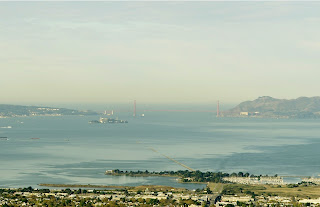 |
| View of the Golden Gate from SSL |
This has led me to think about the ideal conference size and how to improve the conference going experience. First, let me divide conference into two groups: community conferences and topical conferences. Community conferences are things like the AAS meetings, the APS March, April, and regional meetings, and the AGU. These meetings are extremely broad and are designed to reinforce the sense of community felt within the broad confines of an academic discipline. Let me set aside those types of meetings for the rest of this discussion.
The other type of meeting is what I call a topical conference, and I mean that very broadly. This is any type of meeting that is designed to address some sub-field. For me that would cover everything from the Solar Physics Division meeting, which covers all of solar physics and has roughly 300 attendees (depending on the location), to the Flux Emergence Workshop. Any conference focused on a given instrument, observatory, or technique would also count. I imagine that most if not all grad students have attended several such meetings.
There are a lot of variable that control the conference experience, but I want to focus on just one, namely number of attendees. I have attended 2 conference with less than 40 attendees, 2 conferences with between 40 and 80 attendees, 3 conference in the 80 to 150 attendee range, and 2 conferences with more than 150 attendees. Here is my ranking of conference size based on my experiences, from best to worst:
- Less than 40: This size encourages extensive interaction with the entire group. The group is small enough that everyone knows everyone by the end of the week and there is ample opportunity to discuss the details of each person's research. This size also forces a strong topical focus.
- 80 to 150: This size means that the meeting has some topical focus but is big enough to bring in a large cross-section of the sub-field. With a group this size you are likely to have a few people whose research is extremely relevant to yours to talk to.
- More than 150: This size means that pretty much every major research group in your sub-field will be represented. The major challenge is finding the people you want to talk to and actually finding time to have a meaningful conversation.
- 40 to 80: This size of conference comes in last because these are generally too large for an extremely focused meeting but not large enough to bring in a good cross section of the sub-field.
I think both large and small conferences are needed. If you never had conferences like AAS with thousands of scientists you would never see and talk with people from a broad spectrum You would be stuck in your niche all the time never able to escape.
ReplyDeleteWhen I was at AAS, for example, I got to talk to some people in person finding these new exoplanets. It was very interesting talking to them in person and if it wasn't for conferences like AAS I don't know how often I would run into them.
On the other end of the spectrum, sometimes it you need to spend a few days with people specifically tied to your research and get some good ideas worked out. I attended a small conference like this at Berkeley myself and it was great.
So I think both are needed: a general AAS type meeting once or twice a year so ideas can cross-contaminate across research areas and smaller conferences where each niche breaks off and works out the details of their research.